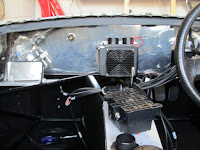Bonnet check
I offered up the dash support panel and roughly clamped in place to check the fit:
First up - removed the clecos and offered up the bonnet to check the fit - bearing in mind there are no catches in place etc it doesn't look too bad:
Advice
I spent some time on the phone to Simon @ GBS to get some advice. While the scuttle panels seemed to fit ok there were a couple of areas I wanted to check:
- The corners of the firewall were being pushed rearwards by the scuttle panel stretched over it
- How good should the bonnet fit be
The advice was broadly; it should be possible to fit the panels without adjustment & by pushing the firewall forwards it will push the scuttle into the right shape. The bonnet should also fit correctly without adjustment & it changes shape slightly when the bonnet latches are fitted - they pull it down onto the chassis rails and around the scuttle evening out any gaps.
Tab Adjustment
I decided to re-work the tabs on the firewall and dashboard support panel, making sure they were flush with the edge and not standing proud at all; The firewall was adjusted in place using some scrap wood as a guide then carefull hammering to tighten up the bend:
The dash support panel on the vice, but the same approach:
Dash support panel prep
I decided to fit the dashboard support panel next to give the scuttle a little structure. Riveting each tab is likely overkill, I think GBS spot weld these.
I ran a guide line along the edge to show how far the rubber edging will eventually cover then worked my way from the centre, drilling and holding with a cleco all the way to the edges. The tabs actually bend past 90 degrees along the top edge:
Pretty happy with the result:
Dash support panel fitting
Next step is to put the panel back on the car to get the correct shape and rivet the rear edge. I used an old 9mm drill bit to countersink the holes:
I'm not over keen on the flush rivets, they look good on the top surface but leave a mess on the back & dont pull very tight:
Final adjustment & cleanup
Off again to cleanup - the cutouts I made on the front edge needed adjusting a little to let the scuttle sit forward enough & the underside of the flush rivets cut back to the internal steel pin:
Just a quick check to see how much the dashboard will need adjusting; doesn't look too bad:
Fit & bond
Final step,
I glued up the edge between the dash support panel and the scuttle, then mounted it in place on the chassis to get the correct shape. The panel is held in place with its bolts & a ratchet strap with rags strategically placed to put pressure in the right areas.
Then a line of bond along the front edge: (I'm going to re-visit this when the whole scuttle assembly comes back off)
The bond needs to go off & cure for a good day or so before I'm moving anything; then the front edge needs some rivets & the tabs cutting off and it should be pretty much done.
Roughly 2.5 hours work - lots of progress !































































